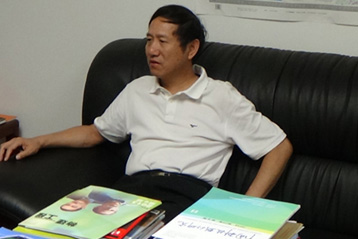A three-step plan for the international development of Chinese scientific journals

A pioneer in reforms and development of Chinese academic publications, Dr. Yan, over many years, has dedicated himself to the study of innovation in and internationalization of Chinese journals. Backed by his experience with a fellowship in journal editing, publication, and technology in the UK, he has published papers about the desired spirit and charisma of journal editors and about how university publications can expand into journals. He currently chairs the Society of China University Journals.
In 2014, Dr. Yan attended the ORCID 12th Biennial Conference in Chicago as the leader of delegates from the Society of China University Journals (CUJS). ORCID invited Dr. Yan to discuss the issue of removing ambiguity in researchers’ names in China as well as how ORCID could help improve the scientific research results tracking system in China.
Shortly thereafter, the CUJS delegates attended the first China-Brazil Scientific Journal Publication exchange event. This event was hosted jointly by CUJS and FAPESP (Fundação de Amparo à Pesquisa do Estado de São Paulo). Many journal editors from China and Brazil spoke at the event. At this event, several scientific journal editors from Brazil became very interested in the “plan to enhance the international prominence of Chinese scientific journals,” which was implemented in cooperation with the China Association for Science and Technology in 2013.
At the 36th annual conference of the Society for Scholarly Publishing (SSP) in Boston, May 2014, Dr. Yan was invited to present a report on how China has adopted new measures to enhance the international prominence of its scientific journals.
Earlier this year, you and your coworker Mr. Zhang Xin published an article titled [translated] “How does the scientific journal serve the development of innovative countries – three steps for Chinese scientific journals.” This article received considerable recognition from the academic publishing industry. Could you explain to us these “three steps” in detail?
As the first step, over three to six years, we would like to publish research results that have a global impact in our own English-language journals; this will help improve the international status of Chinese journals.
Currently, English is the primary language for scientific communication around the world. More than 5800 English journals around the world are included in Thomson Reuters' Science Citation Index (SCI); however, journals from mainland China account for merely 2% of them, falling far behind journals from the US, UK ,and other countries.As the second step, we would like to to accomplish two things: (1) facilitate institutionalized reform of outstanding scientific journal publishers, and establish publication units for international English-language scientific journals; (2) develop publication platforms for international English-language scientific journals.
Currently, under the pressure of evaluation policies of scientific research, many scientific researchers in China have surrendered their rights on the first publication of their scientific findings as well as their copyrights temporarily to foreign journals; they do so without receiving any compensation and sometimes even pay these journals for this. This poses a great threat to the safety of scientific information resources in China.As the third step, we hope that, by 2020, more and more outstanding results in China will be published primarily in Chinese, before being translated and marketed internationally; in this way, scientific journals will serve as a key medium for innovations in China. Insufficient command over the Chinese language has become a barrier for the international promotion of scientific research results from China.
If we continue to publish outstanding results from China in foreign journals or if we continue to believe that English (a foreign language for us) is the only way to promote Chinese scientific research results, then Chinese scientific journals will become more and more marginalized, and the contribution of Chinese journals to the international standing of the Chinese language will be hindered.What you are proposing is a plan to facilitate innovation in China by enhancing the international standing of Chinese English-language journals. However, from the perspective of authors, currently, SCI publications govern the scientific research evaluation system, which is closely linked to their career development, fund aquisition, etc. What do you believe is the best way to encourage Chinese authors with outstanding results to publish their work in Chinese journals, and more specifically Chinese-language journals? Would this be a big challenge?
 I proposed the “three steps” mainly because this process cannot be realized in the near future. For example, if we force Chinese scientists to publish their work in Chinese journals through regulations, they will not agree to it; Chinese authorities will not agree to this approach either. However, if we keep publishing nationally funded scientific research results in foreign journals, then our research will be regulated by others. Therefore, our government needs to figure out a way to keep these scientific research results to ourselves, and apply them in economic development and social governance in China.
I proposed the “three steps” mainly because this process cannot be realized in the near future. For example, if we force Chinese scientists to publish their work in Chinese journals through regulations, they will not agree to it; Chinese authorities will not agree to this approach either. However, if we keep publishing nationally funded scientific research results in foreign journals, then our research will be regulated by others. Therefore, our government needs to figure out a way to keep these scientific research results to ourselves, and apply them in economic development and social governance in China.In June of this year, at the academicians’ conference between the Chinese Academy of Sciences and the Chinese Academy of Engineering, Chairman Xi Jinping stated [translated]:
“The boundaries between basic research, applied research, technological development, and industrialization are becoming increasingly obscure in the traditional sense. The scientific innovation chain has become more mobile and the updates on technologies and the transformation of results have become more efficient, facilitating corresponding upgrades in relevant industries. Scientific innovation activities are breaking regional, organizational, and technological boundaries, and leading to competition for innovative systems; innovative strategic competition is becoming more and more important to the comprehensive competitions with national strength.”It is important to grasp an in-depth understanding of these words. As innovation in scientific research becomes more diverse, the distance between basic research and industrial development is reduced. As Chinese people continue to produce these scientific research results in large volumes, not only do we have to resolve the publication of these results in terms of “output,” we also have to learn how to apply these results to the economic development and innovative growth of China.
Therefore, as an initial step, we would need to create some decent English-language journals. We need to first retain publication rights in our own hands, and at the same time help our scientists to publish their scientific research results internationally. To do so, we need to understand our current situation and make plans for the long-run.There must be many differing opinions on this.
But to me, this step is reasonable. English is still the primary language of international academic communication. English is also the primary communication tool in basic research and the subsequent industrial and commercial fields. Because foreign scientific researchers may not be able to read in Chinese, we may have to keep publishing in English in the years to come. Therefore, we have to use English to promote Chinese scientific research results internationally through our own communication channels, and at the same time, use these English journals to establish the Chinese brands.
We should retain the first publication rights to ourselves. Also, the copyrights, editorial rights, and databases etc. We can still partner with international publishers and databases. But in the long run, it is better for us to keep our scientific research results.When trying to publish its own English-language journals, will China be competing with journals such as Nature, Science, and PLOS in terms of the range and speed of communications and brands?
However, unlike the West, we do not have a strong channel of communication. Why do many scientists choose to publish in Western journals? Because these journals have far better networks of communication than we do in terms of speed and range. When an article is published in a foreign English-language journal, that information will become available to the world overnight. This is exactly what we hope to accomplish in the next three to five years. After making the decision to create English journals in China and use these journals to improve global academic communication originating from China, the next step would be to decide whether China should have its own international journal publication platform with independent intellectual property rights.
This leads to another issue. There are many such platforms around the world; some inetrnational publishers already partnered up with journals in China and they may not need us at all. In addition, scientific journals in the West have been digitalized for one or two decades, with all functions digitalized, including submissions, publications, and marketing. With such advanced technologies and marketing systems, China may not need to build such a platform from scratch.As mentioned before, we need to think about two issues: (1) whether it would be in China’s best interest to have its own English-language journals that retain first publication rights, and (2) whether we should build our own databases to store basic research data.
In another forum, you recently mentioned that, “publication is not the end of scientific research.” Could you elaborate on this?
We also need to pay attention to the Chinese policies on scientific research evaluation. Currently, evaluation policies as well as many schools and research institutions tend to measure the level of research accomplishment based on where the authors have published their papers and where they have stored their data. Some authorities in China tend to use these indicators to evaluate scientists and research institutions. This has led to another problem: Some scientists, teachers, and students believe that when they publish the paper, they have met their goal and that project is completed. But is publication the very last step for the research work of any project, any institution, or any individual?
From the perspective of developments in scientific research and industries, publication is definitely not the final step. The publication of a paper only completes a single stage in the research process. Any research is done for the benefit of the future, regardless of how long it may take to implement its applications. In the past, there had been much research that took a long period of time: 30 years, 50 years, or even over a life time. Nowadays, as the distance between all stakeholders becomes shorter and shorter, before we even start a research project, we should take into account the potential value its results may have for the future. What is the purpose of a research unless it can be used?Of course, some purely theoretical research or basic research studies may be an exception to this thought.
Since the current scientific research evaluation system tends to stress the completion of the work, many people are under the pressure of time and indicators, and do not make an effort to connect their work with potential future transformations in scientific research. Do you think that on some level, this is a waste of resources in scientific research? How can different stakeholders work together to address this problem?

More and more researchers should be encouraged to think about the future prospects and applications of their research. I firmly believe that research should be conducted with the larger vision of economic development of and industrial progress of the nation. Almost all research---basic or applied research---can serve as the frontrunners of scientific developments. We have been following the Korea Institute of Science and Technology Information (KISTI) recently; in addition to conducting their own research, this institution also provides their research results to enterprises. Relevant enterprises come to KISTI when in need of research and developments. Scientific journals and the publication of papers is only one of the stages in the chain of basic research, research and development, industrial application, and product creation.
At the same time, we cannot be absolute and say that all scientific journals and papers must serve industries; this is neither practical nor reasonable.Thank you, Dr. Yan.
This interview was conducted by Deborah Yang.
Published on: Oct 10, 2014
Comments
You're looking to give wings to your academic career and publication journey. We like that!
Why don't we give you complete access! Create a free account and get unlimited access to all resources & a vibrant researcher community.







